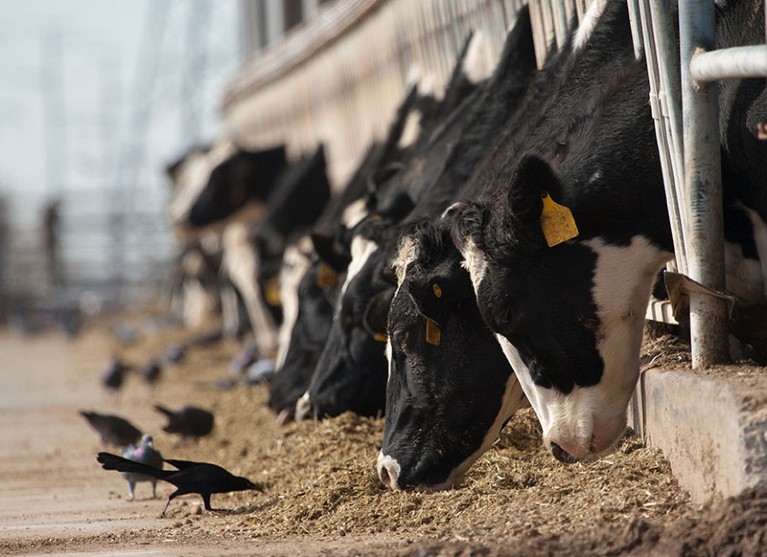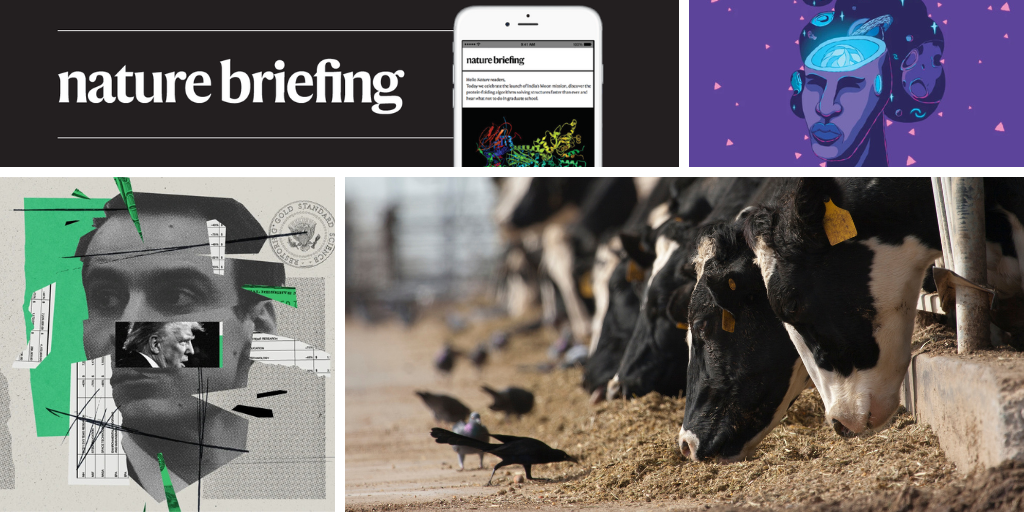You have full access to this article via your institution.
Hello Nature readers, would you like to get this Briefing in your inbox free every day? Sign up here.

“The likelihood is: overbombardment of viruses in the environment is leading to efficient transmission,” says Seema Lakdawala. “They’re inhaling it; they’re probably also finding it on their bodies; they’re licking it; they’re finding it on the milking equipment—all of it together.” (Dusty Pixel photography/Getty)
A preprint study suggests that the H5N1 avian influenza virus is widespread on dairy farms, including in wastewater, in the air in milking parlours and in the exhaled breath of cows — indicating how it is spreading so readily in those environments. “It is everywhere,” says microbiologist and immunologist Seema Lakdawala, who co-authored the study, which has not yet been peer-reviewed. “We need to be expanding biosafety measures, biosecurity measures and trying to control where the virus is.”
Scientific American | 6 min read
Reference: bioRxiv preprint (not peer-reviewed)
The remains of meteorologist Dennis Bell, who died in Antarctica in 1959, have been recovered after being exposed by a receding glacier. Bell was 25 when he fell into a crevasse while doing research for the precursor of the British Antarctic Survey. DNA confirmation of Bell’s remains has solved a “decades-long mystery and reminds us of the human stories embedded in the history of Antarctic science”, says the Survey’s director, Jane Francis.
Astronomers have detected what could be the most massive black hole found yet. It has a mass 36 billion times greater than that of the Sun and lies at the centre of a galaxy around 5 billion light years from Earth. To gauge the mass of a black hole so far away, researchers had to devise a new technique, which relies on light emitted by the matter being sucked inside. It works, but “relies on a lot of assumptions”, says astrophysicist Carlos Melo-Carneiro. As such, astronomers can’t determine the object’s exact mass with much certainty.
Reference: Monthly Notices of the Royal Astronomical Society paper
A plan to save Florida panthers (Puma concolor coryi) from extinction by introducing pumas from Texas has been successful — without wiping out the genetic variants that make Florida panthers unique. Since the Texan animals were translocated in the mid-1990s, the population of Florida panthers has risen from around 30 to over 200, and shows fewer signs of inbreeding. The results are a win, but if the population stops growing, inbreeding could creep back in, says conservation genomicist and study co-author Diana Aguilar-Gómez.
Reference: Proceedings of the National Academy of Sciences paper
Features & opinion
When US President Donald Trump nominated former business executive Michael Kratsios as his chief science advisor, some researchers breathed a sigh of relief. They saw positive signs in the fact that, in past political roles, Kratsios had championed policies on artificial intelligence and quantum computing. Four months after his confirmation, the situation is going sideways. In particular, Kratsios’ first major initiative — a directive calling on federal agencies to promote ‘gold standard science’ — has attracted widespread criticism for undermining and politicizing science. The problem, some argue, is that he isn’t a scientist, and as such doesn’t understand how research operates.
Creativity can be crucial for scientific discovery — but it tends to be undervalued compared with some other skills. And creativity itself is hard to define. At the (In)Credible Research Conference last year, researchers discussed how developing ‘creative oases’ and small grants for risky ideas can help to encourage innovative thinking in the face of time pressures.
When it comes to Trump’s cuts to US funding for the global fight against malaria, the numbers are staggering: a recent estimate found that the US President’s Malaria Initiative would have prevented 13.6 million cases and 104,000 deaths across sub-Saharan Africa this year if it remained fully functioning; it’s not known how much of that capacity will be retained. On the ground, the effects are more urgent and painful than any statistic can capture. In Guinea, Alhassane Camara is one of thousands of health workers who suddenly lost their jobs in January. Without salary or transport, he continues to try to protect those most at risk. “I beg Donald Trump,” he says. “The small children, they die.”
Reference: The Lancet paper
Today I’m ramping up for a night of spectacular stargazing thanks to the Perseids meteor shower, which peaks tonight and is primarily visible in the Northern Hemisphere. Please wish me clear skies (and the ability to stay up later than usual!)
If you spot some shooting stars yourself — or even catch some on camera — I’d love to hear about it. Please tell me all about it — along with any feedback on this newsletter — at [email protected].
Thanks for reading,
Flora Graham, senior editor, Nature Briefing
With contributions by Jacob Smith
• Nature Briefing: Careers — insights, advice and award-winning journalism to help you optimize your working life
• Nature Briefing: Microbiology — the most abundant living entities on our planet — microorganisms — and the role they play in health, the environment and food systems
• Nature Briefing: Anthropocene — climate change, biodiversity, sustainability and geoengineering
• Nature Briefing: AI & Robotics — 100% written by humans, of course
• Nature Briefing: Cancer — a weekly newsletter written with cancer researchers in mind
• Nature Briefing: Translational Research — covers biotechnology, drug discovery and pharma


